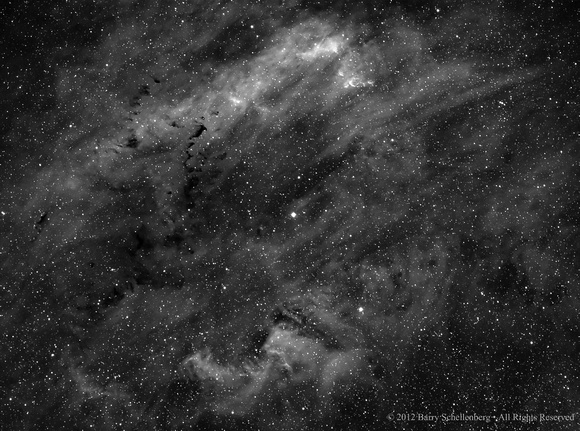Other Names: LBN 391
Optics: Borg Astrograph 101ED at f/4.1
Mount: Atlas EQG using The Sky6 and EQMOD
Camera: QSI 583WS
Filters: Astrodon Ha 3nm
Exposure: 510 Mins, 8.5 hours [Best 102 of 136 x 300s] Ha
Accessories: Auto guided with Borg 45ED and Orion Starshoot Auto Guider using Maxim Guiding
Location: Calgary, AB & Drumheller (site of ASP)
Date: September 10th, 11th & 13th
Notes: Image acquisition with Maxim DL Pro v5.22 using MaxPilote Automation. Processing: Image calibration, align, and combine in Maxim DL Pro. Levels, curves, Noel Carboni's tools, Noise Ninja, crop and resize in Photoshop CS4.
High Res Image: http://astromarina.zenfolio.com/img/s4/v64/p1142043012-6.jpg Calibrated w/40 Darks, 140 Bias, 100 Flats using a light box,
CCD temperature was -20C. Image was taken over multiple nights from my backyard in Calgary and also from Starland, the home of the Alberta Star Party near Drumheller.
Sharpless 119 is a large patch of emission nebulosity in Cygnus, about 3 degrees east of the North American Nebula, located around the bright 5th-magnitude star 68 Cygni (near the image center). S. Sharpless, in his famous "Catalogue of H II Regions", published in 1959, indeed describes it as type 3, "bright". Interestingly, there are several dark lanes and dark globules superimposed on the southern part of the nebula. The area is part of the Milky Way and well populated by numerous stars.
There is a planetary nebula present called We 2-245 and is the small blob to the left of the bright star near the centre. It is one of 6 planetary nebulae that were discovered in 1977 by the astronomer Ronald Weinberger. (thanks to Sakib for pointing this out)


